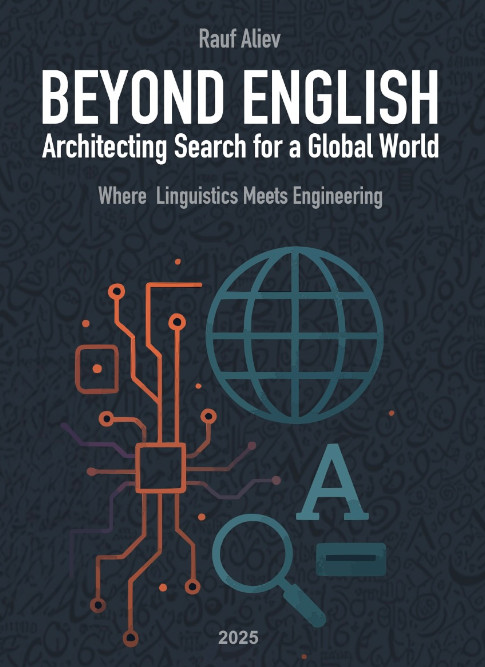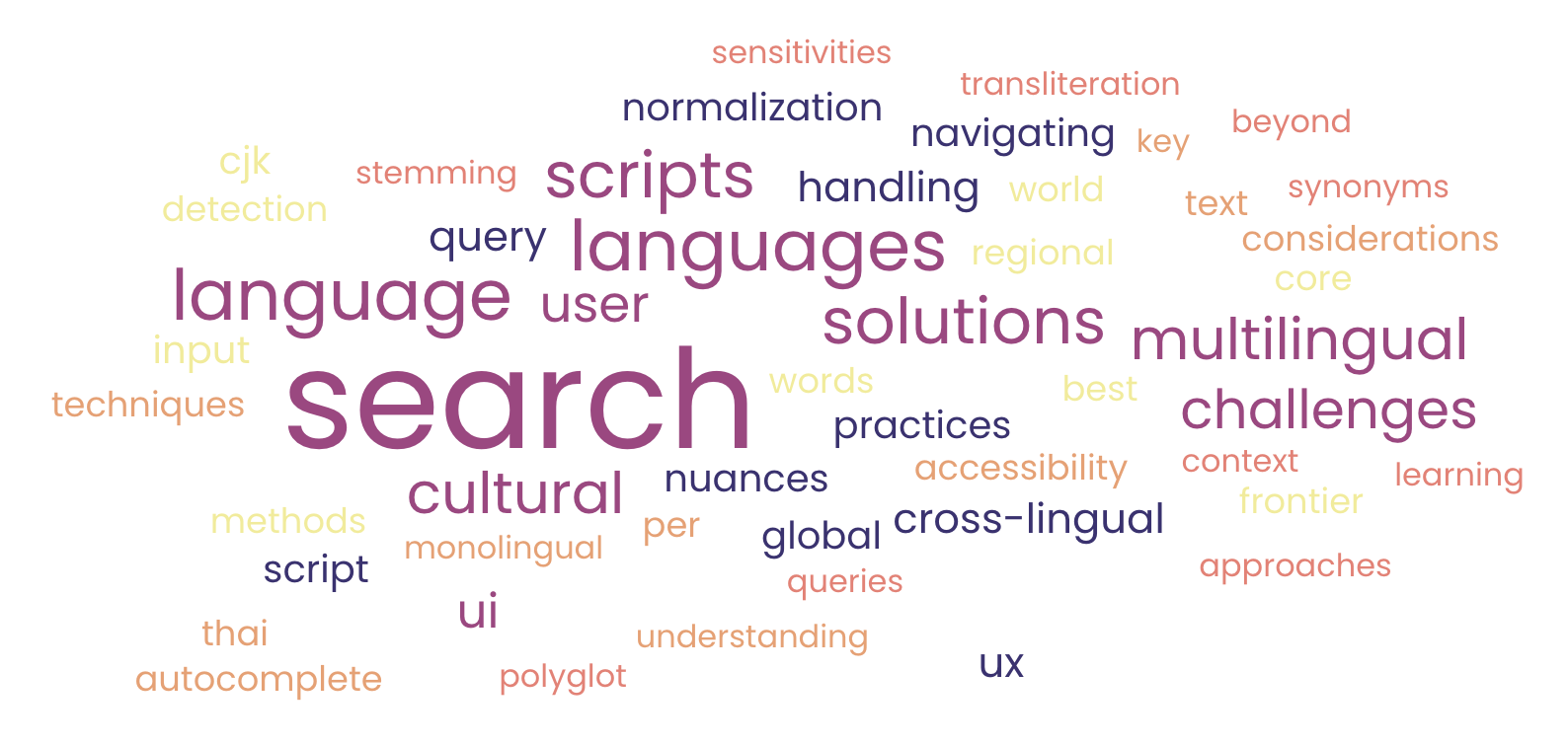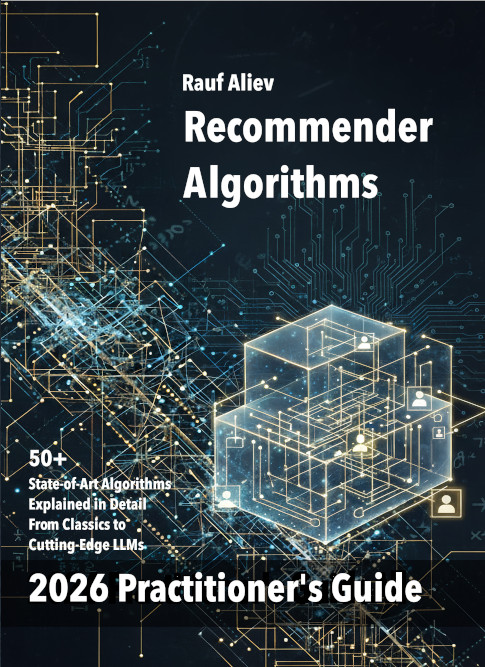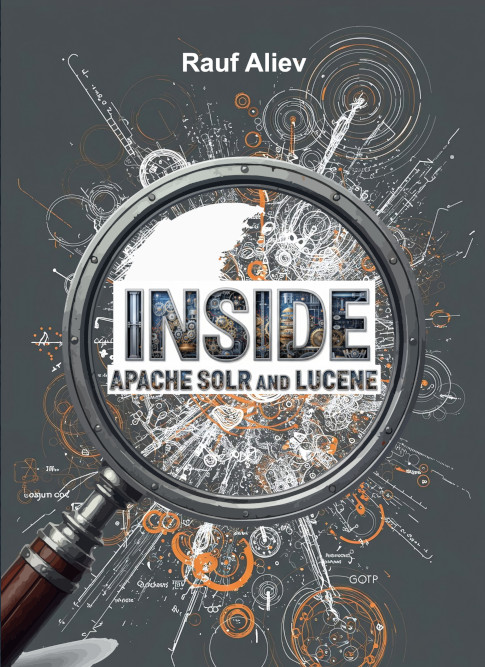
Where to Buy
Amazon USAmazon UK
Amazon DE
Amazon IT
Amazon ES
Amazon PL
Amazon CA
Amazon AU
Amazon India (ebook)
Apple Books (EPUB)
Read Sample (PDF)
Pay for the PDF and I'll send it to you by e-mail: FOR CARD PAYMENTS, PLEASE SEND ME A MESSAGE AS WELL. PAYPAL MAY NOTIFY ME OF THE PAYMENT WITH SOME DELAY.
Beyond English: Architecting Search for a Global World
Rauf Aliev
In a world where over half of all web content is non-English, most search systems are still built on a flawed, English-centric foundation. This "monolingual trap" leads to catastrophic failures in global markets, frustrating users and costing businesses dearly.
The topic started back in 2019 when I published a detailed study on Chinese and Japanese searching on my blog. It eventually evolved into one of the chapters in this book, heavily revised, improved, and expanded. As you can guess, the book is all about building search systems that truly understand users from diverse cultures who speak different languages and often have unique expectations of how a search engine should work.
Who might find it useful? System architects expanding into global markets, or already operating in them. And, more broadly, any engineers curious about how language works and the key features to consider when creating multilingual websites.
Ever wondered…
- In which European countries can users search the same term in their local language or in Latin script interchangeably — and how ignoring this cultural duality can tank your relevance scores?
- How do massive compound German/Dutch words like Fahrkartenautomat (ticket machine) challenge tokenization, and what’s the best way to split them for better recall without losing meaning? How can you avoid undesired word splitting?
- Why does a French search for l’aéroport (the airport) require special handling of elisions and contractions, and how does failing to handle them split words incorrectly and ruin results?
- Why do users in Poland often skip diacritics (e.g., typing zazolc gesla jazn instead of zażółć gęślą jaźń), and how can your system normalize input to match the right documents every time? What edge cases might this create, and how should you handle them?
- In Japanese, why might a user query the same concept as 狐 (kanji for “fox”), きつね (hiragana), or キツネ (katakana), and how do you ensure your search treats all scripts as equivalent?
- For Chinese, how does the lack of word spaces turn a phrase like 东京旅游 (Tokyo travel) into a segmentation challenge — and how do different Chinese language variants demand smart mapping?
- Why can a single word in Khmer be encoded in multiple different ways in Unicode, looking identical to users but breaking search engines — and how do you fix that?
- What makes code-switching in queries (for example, blue साड़ी) so tricky for NLP, and how do you build a system that handles it seamlessly without frustrating users?
The book examines existing approaches to solving these and other similar challenges from a solution architect’s perspective. No, it doesn’t include code examples, but it does contain numerous references to existing tools and academic research.
The Book’s Organizational Framework
Universal Challenges
The book opens by establishing the universal challenges of multilingual search, introducing the “monolingual trap” — the flawed assumption that all users search like English speakers. It presents striking data showing that over half of web content is non-English and clarifies the distinctions between monolingual, multilingual, and cross-lingual search to build a shared conceptual foundation.
The Core Technical Foundation
Next, the book outlines the “Core Components of a Multilingual Search System,” forming the technical backbone for later chapters. It covers language detection for both queries and documents, then explores the indexing pipeline — tokenization, normalization, stemming, and lemmatization — explaining how each must be adapted to different languages.
The Language Family Chapters
The main body of the book consists of language family–based chapters, each following a consistent structure that highlights distinct linguistic and engineering challenges.

Table of Contents
- The Monolingual Trap
- The Inescapable Global User
- The New Digital Ecosystem: A World of Languages
- Why Getting Language Right Isn't Optional
- A Glimpse of the Labyrinth: The Challenges Ahead
- Key Concepts: Monolingual, Multilingual, and Cross-Lingual Search
- Defining the Terms
- The Anatomy of a Monolingual Search Failure
- Over-Reliance on English-Based Assumptions
- Query Understanding: When Your Search is Lost in Translation
- Ignoring Synonyms and Homophones
- Ignoring Regional Variants
- Assuming English-centric stop words
- Ignoring mixed-language queries
- Cultural and UI Oversights: A Flawed Experience
- Why Multilingual Search is a Competitive Superpower
- Improved User Engagement
- SEO Advantages
- Higher Conversion Rates
- Brand Loyalty and Trust
- How to Prove It: Metrics to Track
- Global Search Redefines User Expectations
- Transferred Expectations
- Market Dominance by Numbers
- China and Baidu
- Russia and Yandex
- The Inescapable Global User
- Architecture and Core Components of a Multilingual Search System
- Language Detection and Identification
- Document Language Detection
- Query Language Detection
- The Engineer's Toolkit
- Statistical Methods
- AI-Based Methods
- Metadata and Contextual Clues
- Handling the Polyglot Query
- Handling the Poliglot Documents
- Tools and Libraries
- Challenges and Limitations
- Best Practices for Robust Detection
- Building Your Indexing Pipeline
- Tokenization
- Normalization
- Unicase Languages
- Stemming and Lemmatization
- Best Practices for Your Pipeline
- Understanding User Intent Across Languages
- Parsing and Expansion
- Meeting Users Where They Are
- The Next Frontier
- A Practical Toolkit for Query Processing
- Ranking and Relevance
- The Neural Era
- The Challenge of Multilingual Ranking
- Language-Specific Relevance Factors
- Script and Variant Handling in Ranking
- Accounting for Cultural Relevance
- Tools and Techniques
- Best Practices for Continuous Improvement
- Scalability for Large Character Sets and Diverse Scripts
- Architectural Solutions for a Multilingual World
- Handling the Nuances of Diverse Scripts
- Fine-Tuning for Performance
- Integration with Machine Learning for Deeper Understanding
- The Role of Machine Learning in Multilingual Search
- Key Machine Learning Techniques
- Query Intent Detection
- Advanced Word Segmentation
- Cross-Lingual Embeddings
- Integration Approaches
- Challenges and Best Practices
- Legal and Ethical Issues
- Data Privacy in a Global Context
- The Hidden Biases in Language Models
- Evaluation in Multilingual Contexts
- Key Metrics for Search Evaluation
- The Multilingual Complication
- Strategies for Meaningful Evaluation
- Best Practices for Continuous Improvement
- An Overview of the Modern Search Toolkit
- Open-Source Search Platforms
- Managed Platforms & Overlays
- Search-as-a-Service (SaaS) Platforms
- Language Detection and Identification
- Latin-Based Languages (European and Beyond)
- Deceptive Simplicity
- Challenges in Latin-Based Language Search
- The Subtle Problem of Accents and Diacritics
- Elisions and Contractions
- The Compounding Issue of Compound Words
- The Richness and Risk of Morphology
- Navigating Synonyms and Regional Variants
- The Reality of Mixed-Language Queries
- Solutions for Latin-Based Language Search
- Normalizing Accented Characters with ASCII Folding
- Taming Morphology with Stemming and Lemmatization
- Advanced Tokenization for Fused Words
- Deconstructing Compound Words
- Bridging Gaps with Synonyms
- Managing Mixed-Language Content and Queries
- UI/UX Considerations
- The Keyboard Input Challenge
- Solutions for Keyboard Inputs
- Autocomplete for Accented Characters
- Cultural and Accessibility Considerations
- Solutions per Language
- German
- French
- Spanish
- Portuguese
- Italian
- Catalan
- Turkish
- Scandinavian Languages (Danish, Swedish, Norwegian)
- Slavic and Cyrillic-Based Languages
- The Hidden Complexities of Slavic and Cyrillic Search
- Writing system and Alphabets
- Cases and Inflections
- Free Word Order Paradigm
- The Duality of Script, Richness of Form, and Transliteration
- Regional and Political Sensitivities
- Solutions for Slavic and Cyrillic-Based Language Search
- Taming Morphology with Stemmers and Lemmatizers
- Cyrillic and Latin Conversions
- Additional Normalization Techniques
- UI/UX: Query Suggestions and Cultural Nuances
- Guiding the User with Intelligent Suggestions
- Accommodating Different Input Methods
- Cultural Considerations in Design
- Ensuring Accessibility
- Political Sensitivities in Script Usage
- The State of the Art and Future Directions
- Named Entity Recognition
- Benchmarking Russian IR (Findings from RusBEIR)
- Cross-Lingual Models and Low-Resource Languages
- The Rise of Embedding-Based and Generative Approaches
- The State of the Art and Future Directions
- Solutions per Language
- Russian
- Polish
- Serbian
- Ukrainian
- Bulgarian
- The Hidden Complexities of Slavic and Cyrillic Search
- East Asian Languages (CJK)
- What Makes CJK Search So Hard?
- A Labyrinth of Scripts
- The Illusion of Words
- The Written-Spoken Divide
- Shape-Shifters and Sound-Alikes
- The Wider Context
- Solutions for CJK Language Search
- Finding Meaning in the Stream
- Normalization
- Building Linguistic Bridges
- Pronunciation-Based Search
- The Human Element in CJK Search
- Input Methods
- The Rise of Voice and Visual Search
- Designing the Interface
- Typography and Accessibility
- CJK Search in the Wild
- Persistent Challenges and Practical User Guidance
- Chinese, The Reliability of Romanization and Quote Marks
- Mastering Chinese E-Commerce at Alibaba
- Navigating the Nuances of Japanese Search at Rakuten
- Engineering Search for the Korean Language at Naver
- The Cross-Lingual Unifier at Amazon
- Solutions per Language
- Chinese
- Japanese
- Korean
- What Makes CJK Search So Hard?
- Indic and Thai Scripts
- An Introduction to Indic and Thai Scripts
- The Cultural and Regional Context
- The Unique Puzzles of Indic and Thai Scripts
- A Case Study in Khmer
- Complex Scripts and the Abugida Model
- The Rendering Trap
- The Ambiguity of Tone and Continuous Text
- The Reality of Transliteration and Code-Mixing
- Solutions for Indic and Thai Script Search
- Custom Tokenizers for Complex Scripts
- Unicode Normalization
- Handling Zero-Width Joiners (ZWJ)
- Transliteration, Synonyms, and Mixed Queries
- UI/UX: Navigating Complex Scripts and Dense Layouts
- Virtual Keyboards for Complex Scripts
- Handling Bidirectional Text
- Designing Intelligent Autocomplete and Suggestions
- Embracing Dense Layouts and Varied Navigation
- A Foundation of Accessibility
- Cultural Notes: Beyond the Algorithm
- Regional Dialects
- Script Preferences and User Behavior
- Navigating Cultural Sensitivities
- Solutions per Language
- Hindi
- Thai
- Vietnamese
- Bengali
- Tamil
- An Introduction to Indic and Thai Scripts
- Middle Eastern and Right-to-Left (RTL) Languages
- Focus Languages: Arabic, Hebrew, Persian (Farsi), and Urdu
- The Unique Puzzles of Right-to-Left Search
- The Challenge of Bidirectional Text
- Contextual Letter Forms
- The Ambiguity of Vowel Omission
- Deep Morphological Complexity
- Script and Dialect Variations
- Solutions for Right-to-Left Language Search
- Foundational RTL Support in Indexing
- Normalization for a Vocal-Free World
- Unlocking Meaning with Root-Based Stemming
- Bridging Scripts with Transliteration and Synonym Handling
- UI/UX: Designing for a Right-to-Left World
- The Mirrored Interface
- Intelligent and Adaptive User Input
- Lowering Barriers with Modern Input Methods
- Special Considerations: Navigating Religious and Cultural Nuances
- Religious Sensitivities in Text Processing
- The Cultural and Dialectal Landscape
- The Political and Social Context
- Solutions per Language
- Arabic
- Hebrew
- Persian (Farsi)
- Urdu
- The Next Frontier—Search in African and Emerging Languages
- Focus Languages: Swahili, Amharic, Yoruba, and Hausa
- The Frontier of Search: Challenges in African Languages
- The Scarcity of NLP Resources
- The Nuances of Tonal Languages
- A Diverse World of Scripts
- The Reality of Code-Switching
- Beyond Text: Voice, Vision, and Oral Traditions
- Solutions for the Resource-Scarce Landscape
- Bootstrapping with Transfer Learning
- The Power of Community-Driven Dictionaries
- Tailored Tokenization and Stemming
- Foundational Unicode Normalization
- Integrating Multiple Scripts and Languages
- UI/UX: Mobile-First Designs, Voice Search for Low-Literacy Users
- Mobile-First by Necessity
- The Power of Voice in Low-Literacy Contexts
- Bridging the Input Gap with Keyboards and Autocomplete
- Cultural and Accessibility Considerations
- Growth Opportunities: Expanding Search in Underrepresented Markets
- The Scale of the Market Potential
- A Frontier for Technical Innovation
- Navigating the Remaining Challenges
- Focus Languages: Swahili, Amharic, Yoruba, and Hausa
- Cross-Lingual and Polyglot Search
- Introduction to Cross-Lingual and Polyglot Search
- Cross-Lingual Techniques: Translation, Embeddings, and Semantic Matching
- Translation-Based Approaches
- Embedding-Based Approaches
- Tools and Frameworks
- Challenges and Recommended Practices
- Defining the Terminology
- Real-World Use Cases
- The Core Challenges
- Techniques for Searching Across Languages
- The Direct Approach: Query Translation
- A Semantic Bridge: Multilingual Embeddings
- Combining Strengths: Hybrid Strategies and Knowledge Bases
- The Polyglot User: Architecting for Code-Switching
- Understanding the Phenomenon
- The Core Challenges
- Architectural Solutions
- Designing the User Experience
- Guiding Principles for Implementation
- Analytic vs. Holistic Thinking
- The Study: Measuring Cultural Search Patterns
- Core Findings
- The American Pattern
- The Chinese and Iranian Pattern
- Nuances and Surprising Results
- Practical Implications for Search Architects
- UI/UX Design for Multilingual Search
- Introduction to Multilingual UI/UX Design
- From CJK to a Global Viewpoint
- The Core Challenges of Multilingual UI
- Our Goals in This Chapter
- Search Bars, Facets, and Autocomplete Across Cultures
- The Global Search Bar
- Faceted Navigation
- Autocomplete as Guiding the User's Intent
- Introduction to Multilingual UI/UX Design
- Conclusion: The End of the Monolingual Era
- Beyond the Algorithm: A Recapitulation of the Journey
- A Journey Through the World's Scripts: Key Lessons Learned
- The Universal Principles of Global Search
- The Generative Frontier and the Enduring Importance of Retrieval
- The Engineer as an Ambassador


